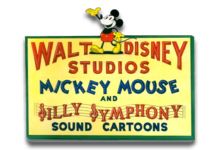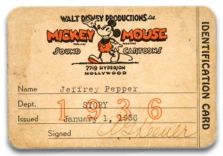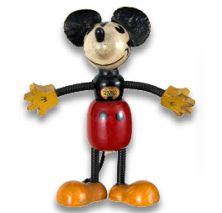 It is a near overwhelming task to quantify the sheer brilliance of the 1933 Mickey Mouse cartoon The Mad Doctor.
It is a near overwhelming task to quantify the sheer brilliance of the 1933 Mickey Mouse cartoon The Mad Doctor.Director Dave Hand clearly intended to borrow style and design from that era's stark yet very stylized black and white horror films. This seven-minute tour de force is heavy on atmosphere and surprisingly, a little bit more chilling and unsettling than one might expect. So much so that it was considered unsuitable for some audiences by a British film censor, and later, 16mm prints carried a similar warning.
The Mad Doctor employs many standard horror story conventions, beginning with its dark and stormy night opening. It then goes on to blend three somewhat disparate themes--a haunted house filled with booby traps and secret passages, threatening creatures in the form of animated skeletons, and the title character and his ambitious plans of body part amalgamation. Let's face it gang, those early Mickey cartoons were not the benign "strolling in the park one day" and "I'll clean up your yard" efforts that characterized his later Technicolor years.
 The tone is established quickly when Pluto is violently kidnapped and taken to a skull rock-perched castle, the ominous and threatening features of which are only clearly revealed in split second lightening flashes. Mickey bravely follows in pursuit and quickly encounters the first in a series of comical yet still decidedly scary booby traps, when the castle bridge disassembles as he moves across it. Still teetering high above the crashing waves of the sea, Mickey is literally pulled into the castle's interior.
The tone is established quickly when Pluto is violently kidnapped and taken to a skull rock-perched castle, the ominous and threatening features of which are only clearly revealed in split second lightening flashes. Mickey bravely follows in pursuit and quickly encounters the first in a series of comical yet still decidedly scary booby traps, when the castle bridge disassembles as he moves across it. Still teetering high above the crashing waves of the sea, Mickey is literally pulled into the castle's interior.  At the same time, a nameplate near the door reveals the villain to be Dr. XXX. This is a distinct aside to Warner Brothers 1932 film Doctor X. That particular film's art direction and set design no doubt inspired Dave Hand and his crew as Mickey and Pluto's subsequent adventures would reveal.
At the same time, a nameplate near the door reveals the villain to be Dr. XXX. This is a distinct aside to Warner Brothers 1932 film Doctor X. That particular film's art direction and set design no doubt inspired Dave Hand and his crew as Mickey and Pluto's subsequent adventures would reveal.Mickey finds himself in a set piece with all the standard haunted house embellishments. Cauldrons, chains and manacles, skulls and bones all litter the entrance foyer, while a swarm of bats emerge from the darkened recesses. Most striking is Mickey's journey down a secret passage that is, in my opinion, one of the single most amazing pieces of animation from those still rough-around-the-edges early days of cartoon production. In this sequence, as Mickey travels down a claustrophobic passage, the view follows him in a continuous shot as he pivots around a corner and tumbles down a long shaft. My son, upon viewing this segment of the short for the first time, immediately exclaimed, "Wow, that was 3-D!" No, actually that was hand-drawn, traditional animation at its finest, where the background elements were ingeniously animated along with central character.
 Following earlier efforts such as The Skeleton Dance and The Haunted House, the comical potential of skeletons is revisited again as Mickey encounters the prank-delivering undead denizens of the doctor's castle. It is here that the very clever designs of the creative team are entertainingly demonstrated, beginning with a coffin-styled cuckoo clock complete with skeletal cuckoo. Equally clever and well-realized is the skeleton-filled stairs that Mickey literally finds himself falling victim too. An ensuing chase scene in which the skeletons lob their own skulls at Mickey builds up the short's kinetic energy, but it's tempered somewhat by the still determined and resilient mouse's encounter with a giant spider skeleton.
Following earlier efforts such as The Skeleton Dance and The Haunted House, the comical potential of skeletons is revisited again as Mickey encounters the prank-delivering undead denizens of the doctor's castle. It is here that the very clever designs of the creative team are entertainingly demonstrated, beginning with a coffin-styled cuckoo clock complete with skeletal cuckoo. Equally clever and well-realized is the skeleton-filled stairs that Mickey literally finds himself falling victim too. An ensuing chase scene in which the skeletons lob their own skulls at Mickey builds up the short's kinetic energy, but it's tempered somewhat by the still determined and resilient mouse's encounter with a giant spider skeleton. At the same time, helpless victim Pluto is mired in troubles of his own. The mad doctor has revealed both himself and his diabolical plans. These plans involve Pluto and an equally terrified chicken and a lot of cutting and dissecting. The doctor's chalkboard diagrams are very funny as is his poetic soliloquy, but Pluto's fear in the scene is so palpable that the short does tangibly shift into a slightly more chilling and for some, no doubt frightening experience. When the mad doctor cuts apart Pluto's shadow, it is almost more disturbing than comical.
At the same time, helpless victim Pluto is mired in troubles of his own. The mad doctor has revealed both himself and his diabolical plans. These plans involve Pluto and an equally terrified chicken and a lot of cutting and dissecting. The doctor's chalkboard diagrams are very funny as is his poetic soliloquy, but Pluto's fear in the scene is so palpable that the short does tangibly shift into a slightly more chilling and for some, no doubt frightening experience. When the mad doctor cuts apart Pluto's shadow, it is almost more disturbing than comical. Despite his own valiant rescue efforts, Mickey soon finds himself in similar circumstances, and with no hope of escape. The story's happy resolution is only accomplished through the "it's all just a dream" plot device. But subtly, this underlying nightmare context is still a bit unsettling--the villain was never vanquished and the heroes were left to some decidedly grisly fates. I can see why some of those early card-carrying members of the theater-sponsored Micky Mouse Clubs may not have left the theater happily whistling "Turkey in the Straw."
Despite his own valiant rescue efforts, Mickey soon finds himself in similar circumstances, and with no hope of escape. The story's happy resolution is only accomplished through the "it's all just a dream" plot device. But subtly, this underlying nightmare context is still a bit unsettling--the villain was never vanquished and the heroes were left to some decidedly grisly fates. I can see why some of those early card-carrying members of the theater-sponsored Micky Mouse Clubs may not have left the theater happily whistling "Turkey in the Straw."But that was, and is still the joy of those early Mickey Mouse cartoons. Most of these endeavors displayed a plucky irreverence that was ultimately lost or diminished in later years. The Mad Doctor both immersed itself in, and at the same time, satirized Hollywood's then fledgling horror genre to great effect. It is certainly a classic piece of animation, and one of the most notable achievements of the Disney Studio's pre-Technicolor years.
Images from The Mad Doctor © Walt Disney Company


















